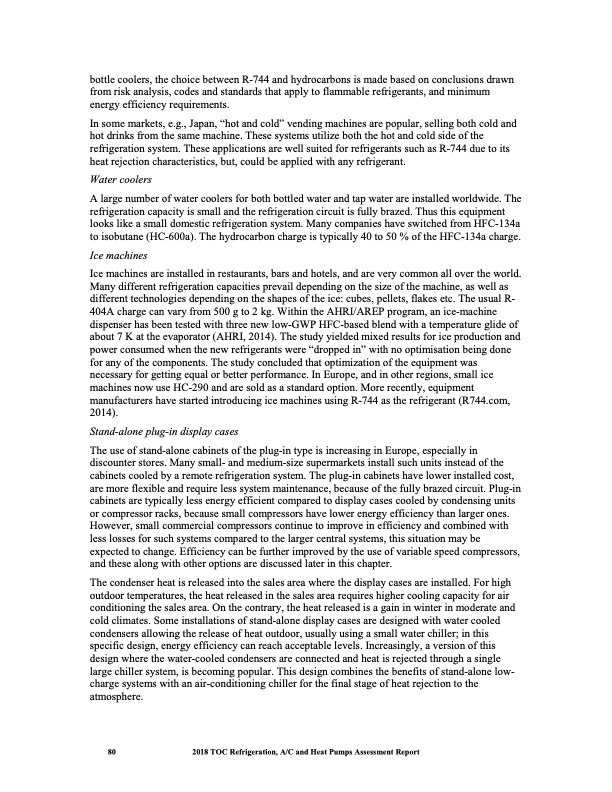
PDF Publication Title:
Text from PDF Page: 093
bottle coolers, the choice between R-744 and hydrocarbons is made based on conclusions drawn from risk analysis, codes and standards that apply to flammable refrigerants, and minimum energy efficiency requirements. In some markets, e.g., Japan, “hot and cold” vending machines are popular, selling both cold and hot drinks from the same machine. These systems utilize both the hot and cold side of the refrigeration system. These applications are well suited for refrigerants such as R-744 due to its heat rejection characteristics, but, could be applied with any refrigerant. Water coolers A large number of water coolers for both bottled water and tap water are installed worldwide. The refrigeration capacity is small and the refrigeration circuit is fully brazed. Thus this equipment looks like a small domestic refrigeration system. Many companies have switched from HFC-134a to isobutane (HC-600a). The hydrocarbon charge is typically 40 to 50 % of the HFC-134a charge. Ice machines Ice machines are installed in restaurants, bars and hotels, and are very common all over the world. Many different refrigeration capacities prevail depending on the size of the machine, as well as different technologies depending on the shapes of the ice: cubes, pellets, flakes etc. The usual R- 404A charge can vary from 500 g to 2 kg. Within the AHRI/AREP program, an ice-machine dispenser has been tested with three new low-GWP HFC-based blend with a temperature glide of about 7 K at the evaporator (AHRI, 2014). The study yielded mixed results for ice production and power consumed when the new refrigerants were “dropped in” with no optimisation being done for any of the components. The study concluded that optimization of the equipment was necessary for getting equal or better performance. In Europe, and in other regions, small ice machines now use HC-290 and are sold as a standard option. More recently, equipment manufacturers have started introducing ice machines using R-744 as the refrigerant (R744.com, 2014). Stand-alone plug-in display cases The use of stand-alone cabinets of the plug-in type is increasing in Europe, especially in discounter stores. Many small- and medium-size supermarkets install such units instead of the cabinets cooled by a remote refrigeration system. The plug-in cabinets have lower installed cost, are more flexible and require less system maintenance, because of the fully brazed circuit. Plug-in cabinets are typically less energy efficient compared to display cases cooled by condensing units or compressor racks, because small compressors have lower energy efficiency than larger ones. However, small commercial compressors continue to improve in efficiency and combined with less losses for such systems compared to the larger central systems, this situation may be expected to change. Efficiency can be further improved by the use of variable speed compressors, and these along with other options are discussed later in this chapter. The condenser heat is released into the sales area where the display cases are installed. For high outdoor temperatures, the heat released in the sales area requires higher cooling capacity for air conditioning the sales area. On the contrary, the heat released is a gain in winter in moderate and cold climates. Some installations of stand-alone display cases are designed with water cooled condensers allowing the release of heat outdoor, usually using a small water chiller; in this specific design, energy efficiency can reach acceptable levels. Increasingly, a version of this design where the water-cooled condensers are connected and heat is rejected through a single large chiller system, is becoming popular. This design combines the benefits of stand-alone low- charge systems with an air-conditioning chiller for the final stage of heat rejection to the atmosphere. 80 2018 TOC Refrigeration, A/C and Heat Pumps Assessment ReportPDF Image | Heat Pumps Technical Options

PDF Search Title:
Heat Pumps Technical OptionsOriginal File Name Searched:
RTOC-assessment-report-2018_0.pdfDIY PDF Search: Google It | Yahoo | Bing
CO2 Organic Rankine Cycle Experimenter Platform The supercritical CO2 phase change system is both a heat pump and organic rankine cycle which can be used for those purposes and as a supercritical extractor for advanced subcritical and supercritical extraction technology. Uses include producing nanoparticles, precious metal CO2 extraction, lithium battery recycling, and other applications... More Info
Heat Pumps CO2 ORC Heat Pump System Platform More Info
| CONTACT TEL: 608-238-6001 Email: greg@infinityturbine.com | RSS | AMP |